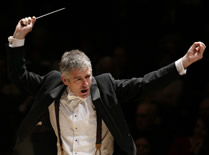Celebrating its fifth season, the floating Keowee Chamber Music Festival opened its first concert of the 2005 season in Asheville on June 17. Kate Steinbeck and Elizabeth Austin have co-directed the bi-state festival since 2003. Their hands-on mechanical and artistic efforts have produced a real gem.
The concept consists of two different programs with six presentations at four venues in both NC and SC including children’s concerts. Diversity is the key. Program I is music by Henry Purcell, J.S. Bach, Gioachino Rossini, Manuel de Falla, Bela Bartók, and Andrea Clearfield (no relation to Asheville cellist/conductor Ron Clearfield). Program II is music by Purcell, Bach, Beethoven, Tania Gabrielle French, Guillo Espel, Gareth Farr, and Lou Harrison.
The roster of players is big-league and professional: Kate Steinbeck, flute, Leslie Warlick, violin, Elizabeth Austin, cello, Amy Brucksch, guitar, Fred Bretschger, double bass, and Byron Hedgepeth, percussion. All are front-rank players, veterans of concerti and chamber music ranks, who bring a wealth of technical and interpretive riches to the stage. On opening night it was all the wood instruments: guitar, cello, double bass, and a grenadilla flute.
On this night, the First Presbyterian Church in Asheville had the ventilation off in honor of a passing cold front, yet inside, at 7:35 p.m., 60+ patrons were getting warm at 78 degrees plus. Guitarist Amy Brucksch put it all in perspective afterward: “As a player I’d rather be warm then cold.” Amen. So in this warm but wonderful all wood and stone structure with a 40-foot ceiling, the music began with Henry Purcell’s “Music for a While,” arranged by Fred Bretschger for bass, cello, guitar and flute. It is an otherwise unremarkable adagio of pleasant sounds and a very good way to open a program.
Next was J. S. Bach’s Suite in D minor, S.1008, for unaccompanied cello, with Elizabeth Austin up. It is the darkest and most artistic of the six suites, and it was nice to hear it played so tastefully. Austin did not repeat the “b” sections of four movements, thus moving the work along. Intonation was superb, and the instrument offered rich color and texture.
Before intermission came Philadelphia-based Andrea Clearfield’s “Three Songs after Poems by Pablo Neruda” (1997), narrated by Tito Amaya of El Salvador. This was as close as we got to contemporary music and easily provided the most artistic depth of the evening. Showing the gift of duende, Amaya recited the poems in Spanish prior to each musical response of flute and bass. The first is a tuneful, atmospheric and metered recitative. The second is similar to the first, showing off greater extremes of instrument range. The third shows more playful interaction between the instruments. The poems are rich, fertile territory for dramatic reading; “Body of a Woman,” “The Light Wraps You,” and “Every Day You Play” are probing and passionate sojourns into the soul of a human roller coaster – and especially so when heard in the native tongue. Chilean Poet Pablo Neruda (1904-73) was a prolific writer and political exile, and his Obras Completas is constantly republished. In 1968, the works comprised 3,237 pages, in two volumes. In 1971 he won the Nobel Prize for Literature.
Following a fifteen-minute intermission, we heard Gioachino Rossini’s Duo, for cello and bass. Composed in 1824, a year after he went to Paris, it is a modest three-movement work exactly like you’d expect from the period and this composer – and more like a party piece. The first section is an incomplete sonata-allegro with familiar declamatory statements. Next comes a slow, thoughtful lyrical and opportunistic calm, and the work ends with an allegro of themes heard often enough to make a Rondo. At that point, such a warm environment and the lack of ventilation caught up with the players, producing intonation problems – not a lot, but enough to be noticed.
Eleven of Bela Bartók’s 44 Violin Duos were played on bass and flute, arranged by Fred Bretschger. The familiar thirty second vignettes explore folk moods and modes. The extreme tessitura is what made these pieces interesting. The bass played one entire movement in harmonics.
Off the program was a last minute insertion – Astor Piazzolla’s “Café 1930,” the second movement from History of the Tango, for guitar and flute. In A-B-A form with an opening monologue by the guitar, this beautifully exemplifies why the guitar-and-flute combination is an efficient chamber setting. Though often sounding disconnected in the A sections, the musicians produced a good balance of sound. Brucksch’s big tone, solid projection, and veteran chamber experience produced a professional dynamic. Steinbeck’s sensual and sumptuous flute accommodated the needs perfectly.
This program ended with “Seven Popular Spanish Songs” by Manuel de Falla, arranged by Fred Bretschger. The famous edition for voice and guitar by Catalonian turn-of-the-century guitarist Miguel Llobet was consulted to produce certainly the best setting of these pieces I’ve ever heard (without voice). Taking the bass voice responsibilities from the guitar opened up both texture and scope of harmony, producing an excellent and fresh reading of these famous songs. The end came after two hours and two minutes with the audience standing and cheering. No encore. No penalty. All were sated.
Note: This program will be repeated 6/19 at 3 p.m. in Pretty Place Chapel at YMCA Camp Greenville, Cedar Mountain, which Steinbeck describes as “a spectacular mountain setting.” After that, three programs will remain: June 23 at the Episcopal Church of the Holy Cross in Tryon; June 24 at Centre Stage in Greenville, SC; and June 26 at the Reuter Center in Asheville (UNCA). Tickets are available at the door. See our calendar or http://www.keoweechambermusic.org/festival.htm for more information.











